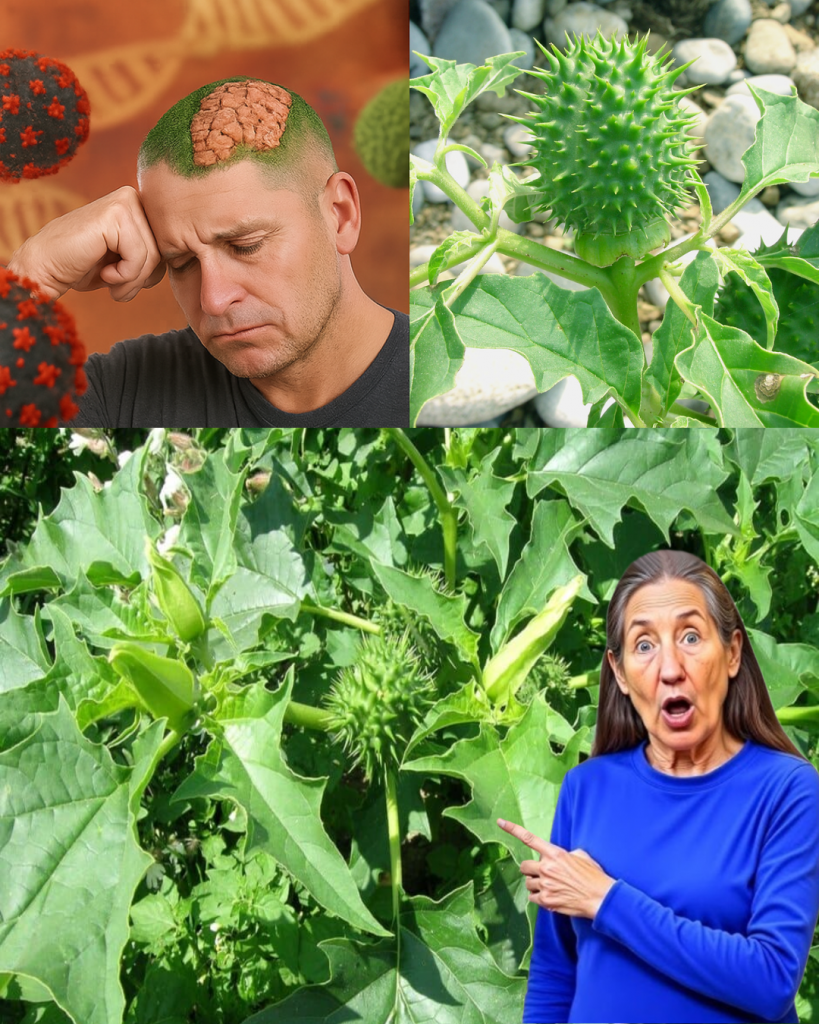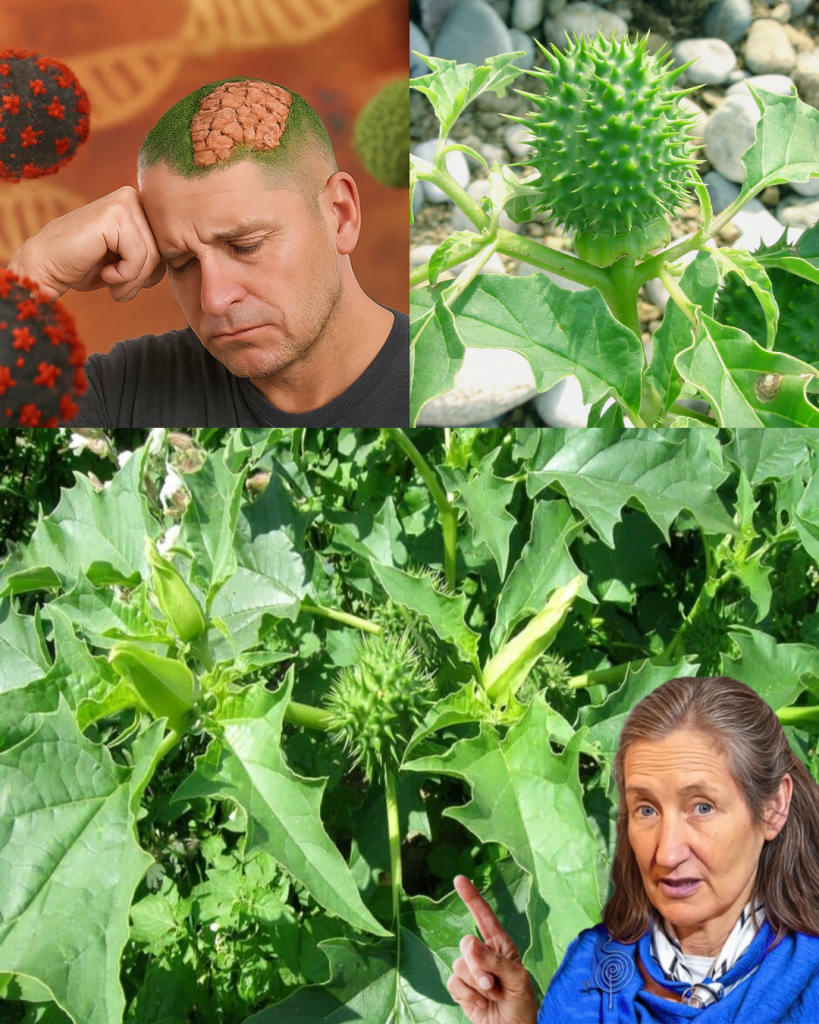Imagine a flower so breathtaking it stops you in your tracks—its glowing, trumpet-shaped blooms shimmering under the moonlight, whispering secrets of ancient rituals and forbidden allure. It grows quietly along roadsides, in abandoned gardens, or even in your own backyard. But beneath its enchanting facade lies a deadly trap. This is Datura, nature’s most seductive and sinister plant, ready to ensnare the curious with a single touch.
Known as Moonflower, Thorn Apple, or Devil’s Trumpet, Datura is no ordinary plant. Its beauty is a mask for a toxic arsenal of alkaloids that can plunge you into a world of vivid hallucinations, heart-pounding chaos, or even death. One moment of curiosity could change everything. Ready to uncover the chilling truth about this botanical deceiver? Let’s dive into the heart of Datura’s danger and discover why it’s one of nature’s most perilous paradoxes.

🌿 A Beautiful Betrayer in Plain Sight
Datura belongs to the notorious nightshade family, Solanaceae, alongside infamous relatives like belladonna and mandrake. Native to the Americas but now thriving globally, it flourishes in disturbed soils, along roadsides, or in gardens where it’s often mistaken for a harmless ornamental. Its giant, fluted flowers—blooming in radiant whites, purples, or yellows—draw gasps of admiration. Its spiky seed pods, resembling medieval weapons, hint at something more sinister.
But Datura’s charm is a deadly illusion. Every part of the plant—leaves, flowers, seeds, even roots—harbors potent tropane alkaloids, a chemical cocktail capable of wreaking havoc on the human body. A single seed can trigger a cascade of symptoms, from disorienting hallucinations to life-threatening heart failure. This is no plant to admire up close. Its beauty is a warning, not an invitation.
🌺 Datura’s Many Faces: Common Species You Might Mistake
Datura’s danger lies in its ability to blend into everyday landscapes, often mistaken for benign flora. Here are the most common species you might encounter—and why you should steer clear.
🌸 Datura stramonium (Jimsonweed)
This is the Datura you’re most likely to stumble across. Its white or purple trumpet-shaped flowers and spiky, menacing seed pods give it an otherworldly appearance. Historically used in shamanic rituals for its psychoactive effects, Jimsonweed is a gamble with death. A small dose can send your body into chaos, with effects ranging from delirium to fatal poisoning.
🌼 Datura metel (Horn of Plenty)
With its ornate, oversized blossoms in white, violet, or gold, Datura metel is a favorite in ornamental gardens. Its beauty is undeniable, but its chemistry is unforgiving. Even traditional healers, who once used it in tightly controlled doses, approach it with extreme caution. One wrong move, and its allure turns lethal.
🌜 Datura inoxia (Moonflower)
Blooming under the cover of night, Datura inoxia’s sweet, seductive fragrance lures the unwary. Often confused with the harmless Moonflower vine, this species has led to tragic mistakes. Its seeds and blooms are packed with alkaloids that attack the nervous system, turning a moment of curiosity into a nightmare.
🌵 Datura ferox (Long-Spined Thorn Apple)
True to its name, Datura ferox is the most menacing of the bunch. Its seed pods, covered in wickedly long spines, scream danger. Larger and more toxic than its cousins, this species is a stark reminder that some plants are best left untouched.
💀 The Lethal Chemistry Behind Datura’s Power
What makes Datura so dangerous? The answer lies in its trio of tropane alkaloids: atropine, scopolamine, and hyoscyamine. These compounds are so potent that they’re used in modern medicine—but only under strict control. In Datura, they exist in unpredictable concentrations, making every encounter a roll of the dice.
These alkaloids target the central nervous system, blocking neurotransmitters and scrambling brain signals. The result is a cascade of symptoms that can escalate from unsettling to catastrophic in minutes. Even minimal exposure—through touch, inhalation, or ingestion—can trigger effects. And when it comes to ingestion, the consequences are nothing short of horrifying.
😵 A Descent into Chaos: Symptoms of Datura Poisoning
Datura doesn’t discriminate. A single touch, a whiff of its smoke, or an accidental ingestion can unleash a torrent of symptoms. Here’s what happens when Datura’s toxins take hold:
- Hallucinations and Delirium: Vivid, terrifying visions that feel indistinguishable from reality, often mimicking psychosis. Victims describe being trapped in a waking nightmare.
- Visual Disturbances: Dilated pupils, extreme light sensitivity, and blurred vision that can last for days.
- Dryness and Discomfort: A parched mouth and throat, difficulty swallowing, and hoarseness that signal the body’s distress.
- Cardiovascular Chaos: Rapid heartbeat, soaring blood pressure, and potentially deadly arrhythmias.
- Critical Collapse: Seizures, unconsciousness, and respiratory failure that can lead to coma or death.
Survivors often describe the experience as a dream they couldn’t escape—a disorienting blend of beauty and terror. For others, there’s no chance to tell the tale.
🏡 Why Datura Has No Place in Your Garden
Datura’s exotic allure makes it a tempting addition to gardens, but its risks far outweigh its beauty. Here’s why you should never let it take root:
⚠️ Unpredictable Potency
No two Datura plants are alike. Alkaloid levels vary widely, meaning one plant might cause mild discomfort while another delivers a lethal dose. There’s no way to predict its power.
🐶 A Threat to Children and Pets
Curious kids and bored pets are drawn to Datura’s striking flowers and spiky pods. A single seed or nibble can trigger life-threatening symptoms, making it a hazard in any family-friendly space.
🚫 No Safe Dose
Unlike some herbs with medicinal uses, Datura has no safe application outside controlled medical settings. Folk remedies involving Datura have led to countless poisonings worldwide.
🐄 A Danger to Livestock
In rural areas, Datura poses a deadly risk to grazing animals. Livestock deaths from accidental ingestion are all too common, turning pastures into minefields.
🛡️ How to Protect Yourself from Datura’s Grip
Encountering Datura doesn’t have to end in disaster. With the right precautions, you can stay safe:
- Never Touch Barehanded: Always wear gloves and long sleeves when handling or removing Datura to avoid skin contact with its toxins.
- Avoid Burning or Composting: Burning Datura releases toxic fumes, and composting can spread its seeds. Dispose of it carefully in sealed bags.
- Spread Awareness: Educate your family, friends, and neighbors about Datura’s dangers. Many are unaware of the risks lurking in their own yards.
- Remove It Immediately: If you spot Datura on your property, eradicate it promptly and thoroughly, ensuring no seeds are left behind.
🌍 Datura’s Dark Legacy Across Cultures
Datura’s mystique extends beyond its biology. For centuries, it has captivated and terrified cultures worldwide. Ancient shamans used it in rituals to commune with spirits, risking death for enlightenment. In medieval Europe, it was whispered to be a key ingredient in witches’ brews, earning its moniker “Devil’s Trumpet.” Even today, it’s both revered and feared in traditional medicine, where its use is reserved for the most skilled practitioners.
This duality—beauty and danger, medicine and poison—makes Datura a botanical enigma. It’s a reminder that nature’s most alluring creations often hide the sharpest thorns.

🌟 The Bigger Picture: Respecting Nature’s Power
Datura isn’t an anomaly. It’s one of many plants that blur the line between beauty and danger, reminding us that nature demands respect. From the deadly oleander to the toxic foxglove, gardens and wild spaces are filled with hidden risks. Staying informed and vigilant is the key to coexisting safely with the natural world.
Datura’s story is a call to curiosity tempered with caution. Its glowing blooms may beckon, but they’re a siren’s song—beautiful, entrancing, and deadly. Whether you’re a gardener, a hiker, or simply someone who loves the outdoors, let Datura be a lesson: not everything that blooms is benign.
🔍 Stay Curious, Stay Safe
The next time you spot a glowing, trumpet-shaped flower swaying in the moonlight, pause before you approach. It might be Datura, nature’s most deceptive masterpiece. Arm yourself with knowledge, keep your distance, and share its story with others. By understanding its dangers, you can protect yourself, your loved ones, and even your pets from its deadly embrace.
Nature is a wonder, but it’s not always gentle. Datura’s beauty is a trap—one you now know to avoid. Stay curious, stay informed, and always tread lightly in the wild.









